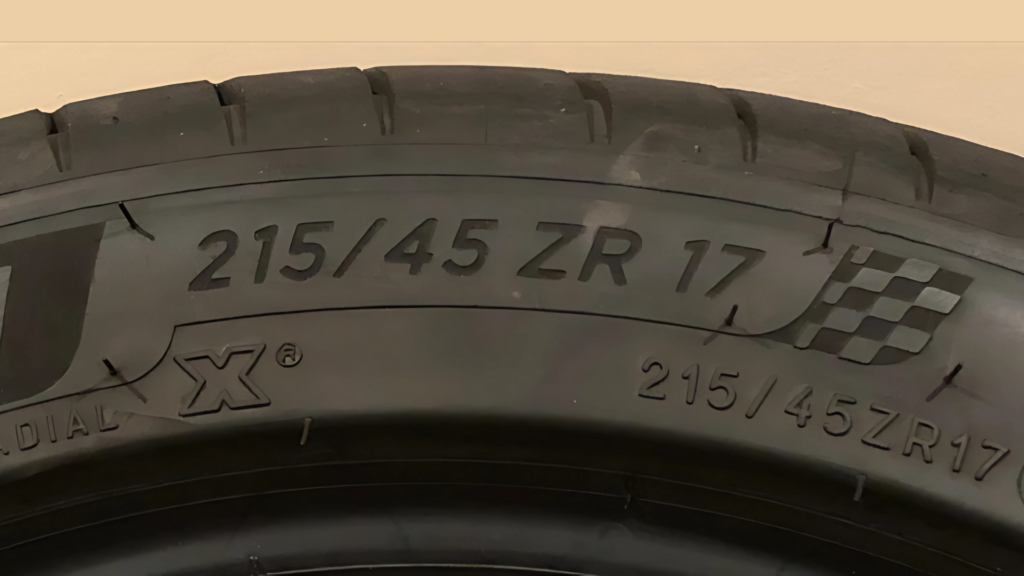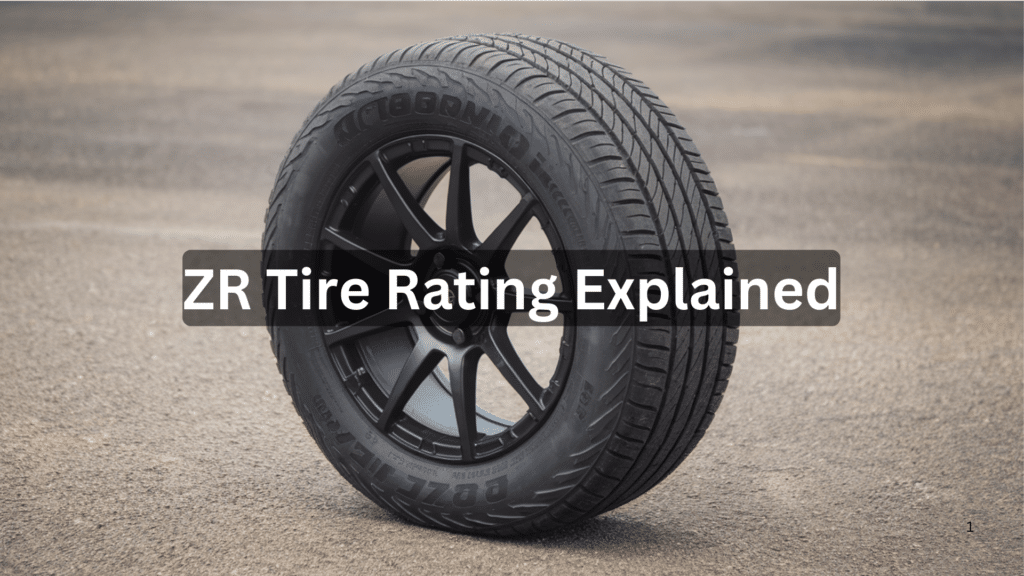Ever looked at your tire sidewall and wondered what all those letters and numbers mean? You are not alone. I’ve spent years helping drivers understand their tires, and today, we’re exploring the mysterious “ZR” rating.
This little code tells you a lot about what your tires can handle. And knowing this might save you money—or even keep you safer on the road. Ready to become tire-smart?
Let’s roll!
What Exactly Is a ZR Tire Rating?

The “Z” in ZR is the highest tire speed rating category. It means your tires are built for speeds above 149 mph (240 km/h).
When you see “ZR” on your tire sidewall, you look at performance tires designed for high-speed driving. The “R” part? That means “radial” construction, which is how most modern tires are made.
These tires have:
- Special rubber compounds
- Reinforced sidewalls
- Unique tread patterns
All these features help handle the extreme heat and stress of high speeds.
Understanding Speed Ratings- Where Does ZR Fit?
Tire speed ratings follow an alphabetical system. Most family cars use S-rated (112 mph) or T-rated (118 mph) tires.
ZR sits at the top of this scale. But here’s where it gets interesting—the Z rating has evolved. Originally, “Z” was the highest speed rating possible.
As cars got faster, manufacturers added:
- W rating (up to 168 mph)
- Y rating (up to 186 mph)
Now, ZR is often combined with these newer ratings. You might see “ZR” with a W or Y, like “275/35ZR19 (96Y)” on the sidewall. Think of Z as saying, “This tire handles 149+ mph,” while the W or Y gives the actual top speed.
When Do You Actually Need ZR-Rated Tires?
Are you wondering if ZR-rated tires are right for your car? I’ve wondered the same thing. Let’s find out exactly when your vehicle or driving style makes these high-speed tires necessary.
You probably don’t need ZR tires unless:
- You drive a high-performance sports car
- You take your vehicle to track days
- Your car’s manufacturer specifically requires them
Most of us never approach speeds where ZR ratings matter. The fastest highways in America have speed limits of 85 mph—far below what even an S-rated tire can handle. But there’s more to consider than just speed.
ZR tires offer better handling and grip at all speeds. If you enjoy spirited driving on winding roads, you might appreciate these benefits even at legal speeds.
Pros and Cons of Choosing ZR Tires
ZR-rated tires offer high-speed performance, but they’re not for everyone. I’ve seen both the benefits and drawbacks firsthand.
You need to know here before deciding if they’re right for you.
Pros:
- Superior handling at high speeds
- Better cornering grip
- Responsive steering feel
- Designed for performance-driving
Cons:
- More expensive than lower-rated tires
- Typically wear out faster
- Usually provide a firmer (sometimes noisier) ride
- May perform poorly in cold weather or snow
- Reduced fuel efficiency due to rolling resistance
Is the trade-off worth it? That depends on your priorities.
How ZR Tire Rating Affects Your Driving Experience
ZR tires change how your car feels on the road. The stiffer sidewalls make steering more precise. You’ll notice your car responds faster when you turn the wheel.
Cornering improves too. The car feels more planted as you go around bends. But there’s a downside. That same stiffness means you’ll feel more bumps and road imperfections. Your quiet commute might become a bit louder and less comfortable.
Some ZR tires perform less well than all-season options in rain or cold weather. The compounds that help at high speeds can become hard and less grippy when cold.
Are ZR-Rated Tires Worth the Cost?
Let’s talk money. ZR tires typically cost 20-40% more than standard touring tires. They also wear out faster—often lasting 20,000-40,000 miles versus 60,000+ for regular tires.
That adds up quickly.
The extra cost rarely makes sense for a daily driver who never sees a racetrack. You’re paying for performance you’ll never use. But the improved handling might justify the expense if you drive a high-performance car or enjoy canyon carving on weekends.
The real question is: what do you value most? Comfort and economy? Stick with standard tires. Performance and handling? ZR tires might be worth every penny.
Common Myths About ZR Tire Ratings
There’s a lot of confusion about ZR tire ratings, and I’ve heard plenty of myths over the years. Some people think they’re only for race cars, while others believe they last longer than regular tires.
Let’s clear up the most common misconceptions so you can make the right choice.
Myth 1: ZR Tires Are Always Better than Other Tires
Truth: They’re better for specific purposes, not for everyday driving in all conditions.
Myth 2: If My Car Came with ZR Tires, I Must Replace Them with ZR Tires
Truth: You can often downgrade to H or V-rated tires if you never drive at high speeds.
Myth 3: ZR Tires Make Any Car Faster.
Truth: Tires don’t add horsepower—they just help manage the power you already have.
Myth 4: ZR Ratings Only Matter at Top Speeds.
Truth: The construction that allows high-speed capability also improves handling at lower speeds.
Knowing these facts helps you make smarter choices about what actually matters for your driving needs.
Tips for Maintaining ZR-Rated Tires
ZR-rated tires are built for high performance but need proper care to last. I’ve learned that small maintenance steps can make a big difference in keeping them in top shape.
Here are some simple ways to extend their life and maintain performance:
- Check Pressure Monthly: Performance tires are sensitive to pressure changes
- Maintain Proper Alignment: Keep them properly aligned. Even small alignment issues cause rapid wear
- Rotate Regularly: Rotate every 5,000-7,000 miles to ensure even wear
- Monitor Tread Depth: Watch the tread depth carefully. Performance tires have less useful tread to begin with
Good maintenance helps you get the most value from your investment.
Conclusion
ZR tire ratings represent the highest speed capability in the tire world, designed for performance above 149 mph.
For everyday drivers, they’re often unnecessary—a premium feature you’ll rarely use. But for performance enthusiasts, they deliver handling benefits that transform your driving experience.
The decision is personal. Balance your driving style, vehicle needs, budget, and performance expectations.
Remember that tire choice affects safety, comfort, and your wallet. ZR tires excel in specific situations but come with cost, comfort, and longevity trade-offs.
Choose based on how you drive—not just what came on your car or what sounds impressive. The right tire isn’t always the fastest-rated one. It’s the one that best matches your real-world driving needs.
Frequently Asked Questions
Can I Mix ZR Tires with Other Speed Ratings on My Car?
Never mix speed ratings across your axles. This creates dangerous handling imbalances, which can lead to loss of control, especially during emergency maneuvers.
Do ZR Tires Improve My Car’s Fuel Economy?
They typically reduce fuel economy by 1-3%. The compounds and construction that improve grip create more rolling resistance, requiring more fuel to maintain speed.
Will Insurance Companies Charge More if I Have ZR-Rated Tires?
Insurance companies don’t typically track tire specifications. Your rates depend on your car model, driving history, and coverage level, not your tire choice.
How Much Shorter Is the Lifespan of ZR Tires Compared to Standard Tires?
Expect 30-50% fewer miles from ZR tires. While standard tires might last 60,000+ miles, many performance tires need replacement after 25,000-40,000 miles.
Can ZR-Rated Tires Improve My Braking Distance?
Yes, due to improved grip, they can shorten braking by 3-10 feet from highway speeds, but only when new and in favorable conditions (dry roads, warm temperatures).


